World Post Day: World Post Day is celebrated on 9th October every year to mark the anniversary of the Universal Postal Union (UPU), which was established in 1874. The UPU was the world’s first revolutionary move in global communication and enabled people to send letters to each other across the globe. World Post Day commemorates this union and highlights the role that the postal service plays in keeping people connected worldwide.
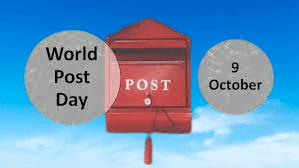
World Post Day
Postal services have played a significant role in connecting people around the world. Even centuries ago, people found a way to communicate with each other through posts delivered by horsemen or messengers. Of course, those methods of communication were complicated and are obsolete in the current times. But postal services remain relevant even today. To honor the people carrying out postal services, we celebrate World Post Day every year on 9th October.
This history of World Post Day goes back to 1874 when the Universal Postal Union was established in Switzerland through the Treaty of Bern. This treaty eased the complex and time-consuming inter-country postal process. It also made postal services more accessible to the world and, therefore, brought about a communications revolution in the world.
The Treaty of Bern was signed by 21 countries, and in 1948, the UPU became a specialized agency of the United Nations. Here is the complete World Postal Day timeline –
- 1874 – Treaty of Bern was signed in Switzerland, and Universal Postal Union was formed.
- 1948 – UPU becomes an agency of the United Nations.
- 1969 – The first World Post Day is celebrated on 9th October.
National Postal Day, India
The service of the India Post is honored by the National Postal Day, which is observed on 10th October every year. In India, the National Postal Day is celebrated annually on 10 October, as an extension of World Post Day, which is celebrated on 9 October. The Day aims to commemorate the role played by the Indian postal department for the past 150 years, which was founded in 1854 by Lord Dalhousie.
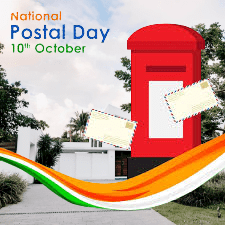
India’s PIN Code system ( Postal PIN Code means ):
PIN in Pin code stands for Postal Index Number. The 6-digit PIN system was introduced by Shriram Bhikaji Velankar, an additional secretary in the Union Ministry of Communications on 15 August 1972. The first digit of the PIN code marks the region. The second digit denotes the sub-region. The third digit marks the district. The last three digits show the post office under which a particular address falls.
The Postal Index Number (PIN, or sometimes redundantly PIN code) is a six-digit postal code. There are nine postal zones in the country; the first eight are geographical regions, and the ninth is reserved for the Army Postal Service (APS905898).
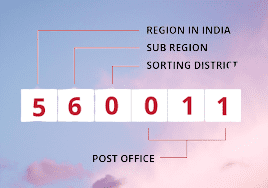
The PIN system is organized in the following way:
- The first digit indicates the zone.
- The first two digits indicate the sub-zone (or postal circle).
- The first three digits indicate a sorting district.
- The first four digits indicate a service route.
- The last two digits indicate the delivery post office.
The PIN for an address may be found on the Postal Service website
Postal Zones in India
There are nine postal zones in India; the first eight are geographical regions, and the ninth is reserved for the Army Postal Service (APS905898)
There are nine postal zones in India, including eight regional zones and one functional zone (for the Indian Army). The first digit of a PIN indicates the zone and is allocated over the 9 zones as follows:
- North Delhi, Haryana, Punjab, Himachal Pradesh, Jammu and Kashmir, Ladakh, Chandigarh
- North Uttar Pradesh, Uttarakhand
- West Rajasthan, Gujarat, Daman and Diu, Dadra and Nagar Haveli
- West Maharashtra, Goa, Madhya Pradesh, Chhattisgarh
- South Telangana, Andhra Pradesh, Karnataka
- South Tamil Nadu, Kerala, Puducherry, Lakshadweep
- East West Bengal, Odisha, Arunachal Pradesh, Nagaland, Manipur, Mizoram, Tripura, Meghalaya, Andaman and Nicobar Islands, Assam, Sikkim
- East Bihar, Jharkhand
- APS Army Postal Service (APS), Field Post Office (FPO).
Each pincode has one post office , which receives all the mails that has to be delivered to one or more postal offices within its area (all of which share the same postal code). Postal codes doesn’t just provide a seamless system to deliver mail/courier , it also forms the backbone of the ecommerce and logistics business in India.
India Post
India Post is a government-operated postal system in India, and is the trade name of the Department of Post under the Ministry of Communications. Generally known as the Post Office, it is the most widely distributed postal system in the world. Warren Hastings had taken initiative under East India Company to start the Postal Service in the country in 1766. It was initially established under the name “Company Mail”.
It was later modified into a service under the Crown in 1854 by Lord Dalhousie. Dalhousie introduced uniform postage rates (universal service) and helped to pass the India Post Office Act 1854 which significantly improved upon 1837 Post Office act which had introduced regular post offices in India. It created the position Director General of Post for the whole country.
India has the largest postal network in the world with 1,55,618 post offices and over 5,66,000 employees. The modern postal service in India is more than 150 years old.
The world’s highest post office is also located in India (Hikkim) which is located at 15,500 feet, Hikkim is part of the Lahaul and Spiti district in Himachal Pradesh.
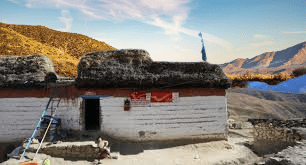
The Highest PO- Hikkim
Hanging at 15,500 ft over the sea level in Himachal Pradesh’s glorious Spiti Valley lies a small cabin with snowy walls and a red letterbox. The nearest town Kaza is 23kms away from it but even then, beating all odds, the frail but picturesque post office has been functioning since November 5, 1983. Internet and mobile phone signals are non-existent in these isolated valleys, leaving post as the residents’ only medium to reach the outside world. Every day, two dedicated runners hike to Kaza in turns to deliver the mail, which is then taken to Reckong Peo by bus, then to Shimla, further to Kalka by train and lastly to Delhi from where it’s sent to its final recipients.
Floating Post Office- Srinagar
The Floating Post Office in Srinagar claims to be the only one of its kind in the entire globe and is constructed atop a finely carved houseboat. While floating on Dal Lake, one can use all regular postal services here. A historic post office that has been in operation since colonial times, it was once known as the Nehru Park post office until John Samuel, the previous head postmaster, changed its name in 2011. The mark used on everything posted from this distinctive post office features a striking image of a boatman rowing a shikara on the Dal Lake, along with the date and address.
On the banks of Kashmir’s Dal Lake, amid rows of waiting wooden shikari boats, rests what is believed to be the only floating post office in the world. Two-centuries old, the two-room houseboat moored near Nehru Park in Srinagar city serves not only the community living by the lake but also the curiosity of visiting tourists from all across the world.
The floating post office itself dates back to 1953, when the local postal department established a mobile delivery service for residents near the lake. Tourists would often come to stay in several of the community-owned houseboats.
At a time before the internet and mobile phone networks, the mobile postal service was a crucial lifeline, collecting letters and postcards and posting them to families back home. The floating post office was officially opened in 1970 by an Indian minister of state and was renovated in 2011. Today, it has three full-time employees and is one of the 1,700 permanent post offices in Jammu and Kashmir.
“The post office also provides a special postal seal with the image of the shikara boat that is stamped on all postcards,” says Ajay Pandita, an officer at the general post office in Srinagar city centre – where post from the floating office is taken at the end of each day for onward delivery.
Dakshin Gangotri Post Office – Antarctica
Situated in Dakshin Gangotri, India’s first scientific outpost in Antarctica, was established during the third Indian expedition to the arctic “White Continent” and opened for business on February 24, 1984. It was a component of the base’s multi-support systems, which also comprised labs, storage, and entertainment areas as well as ice-melting equipment. On January 26, 1988, the Dakshin Gangotri PO was integrated into the Department of Post in Goa. Its first honorary postmaster was scientist G. Sudhakar Rao, who travelled to Antarctica in 1987 as part of the Seventh Indian Scientific Expedition. Interestingly, this post office posted and cancelled close to 10,000 letters in its first year of operation.
Underwater Post Office – Hideaway Island, Vanuatu
Vanuatu, an archipelago republic made up of 83 islands in the South Pacific, is home to the only recognized underwater post office in the world. The working post office debuted in 2003 and is nine feet underwater close to Hideaway Island. It has been a treat for both snorkelers and divers. You can buy waterproof postcards at gift stores on land if you wish to send mail from Vanuatu’s Underwater Post Office. The underwater clerk will approve the mail using an embossed cancellation tool rather than stamping the postcard with ink.
The Central Post Office – Manila
The Manila Central Post Office is the head office of the Philippine Postal Corporation. It is located on the bank of the Pasig River in the historic fortified part of the Philippine capital city. The structure designed in neoclassical style was built in 1926 but suffered severe damages during the Second World War. Thankfully, the edifice was restored to its original splendor after the war and has inspired local students of architecture and those around the world with its immaculate design ever since. The Manila Central Post Office Building was designated an Important Cultural Property by the National Museum in November 2018 due to its historical importance and inherent beauty.
The first post office in India was started by the British East Indian Company in 1764.
Mahatma Gandhi was the first person whose picture was depicted on free India’s stamp (1948).
India was the first country in the Commonwealth to issue airmail stamps.
World’s first official airmail – The flight took of from India on 18 February 1911 and covered a distance of 18 km from Allahabad to Naini.
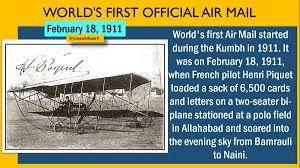
Due to the increase of digital services, Indian Post had terminated two important services – Telegram (in 2013) and Money order (in 2015).
The first post office was opened in 1727 in Calcutta (now Kolkata).
Vision and Mission of India Post
Vision
India Post’s products and services will be the customer’s first choice.
Mission
- To sustain its position as the largest postal network in the world touching the lives of every citizen in the country.
- To provide mail parcel, money transfer, banking, insurance and retail services with speed and reliability.
- To provide services to the customers on value-for-money basis.
- To ensure that the employees are proud to be its main strength and serve its customers with a human touch.
- To continue to deliver social security services and to enable last mile connectivity as a Government of India platform.
Core Values
We will maintain our iconic status as a unique and trusted national institution by:
- Always providing the human touch in all our interactions with society
- Being responsive and reliable
- Demonstrating the highest order of integrity, honesty, transparency and professionalism
- Discharging our responsibilities towards the society in an environment of deep trust, mutual respect and a culture of service before self
Strategic Goals
Achieve the long term goal of financial self-sufficiency by generating surpluses from services (existing & new) outside our universal service obligation
- Develop, implement and operate a system of standards with accountability for performance
- Develop a scalable and flexible technology infrastructure to support our operations
- Be the preferred, trusted and reliable service partner for all customers
- Ensure that India Post acquires all required people capabilities to deliver its chosen services portfolio
- Be the interface between citizens and the government
23 Postal Circles in India
For providing postal services, the whole country has been divided into 23 postal circles.
Each Circle is co-terminus with a State except for Gujarat Circle (which also administers the Union Territories of Daman & Diu and Dadra & Nagar Haveli)
Kerala Circle (which includes the Union Territory of Lakshadweep)
Maharashtra Circle (which has within its jurisdiction the State of Goa)
North East Circle (which comprises six North Eastern States – Arunachal Pradesh, Manipur, Meghalaya, Mizoram, Nagaland & Tripura)
Punjab Circle (which has within its administrative jurisdiction, the Union Territory of Chandigarh)
Tamil Nadu Circle (which also administers the Union Territory of Pondicherry)
West Bengal Circle (which also administers the state of Sikkim and the Union Territory of Andaman and Nicobar Islands) .
Each of these Circles is headed by a Chief Postmaster General.
Each Circle is further divided into Regions comprising field units, called Divisions (Postal / RMS Divisions).
Each Region is headed by a Postmaster General.
In the Circles and Regions there are other functional units like Circle Stamp Depots, Postal Stores Depots and Mail Motor Service etc.
Besides these 23 Circles, there is another Circle, called Base Circle, to cater to the postal communication needs of the Armed Forces. The Base Circle is headed by an Additional Director General, Army Postal Service in the rank of a Major General. The officer cadre of the Army Postal Service comprises officers on deputation from the Civil Posts. Seventy five percent of the other ranks of the Army Postal Service are also drawn from the Department of Posts and the remaining personnel are recruited by the Army.
The headquarter of India post is called as Dak Bhawan situated at Sansad Marg, New Delhi.
For other general awareness topics, please visit read4knowledge.com.